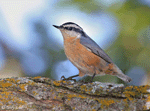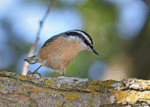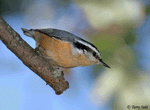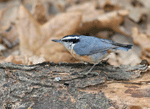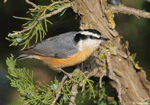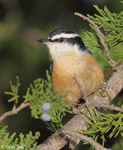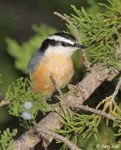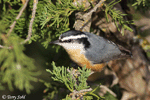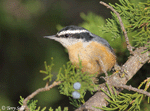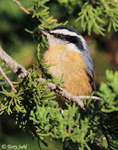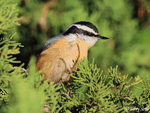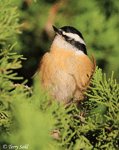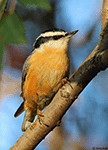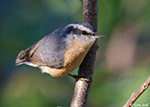| Length: 4.5 inches | Wingspan: 8 inches | Seasonality: Winter / All Seasons |
| ID Keys: Size, Black eyestripe, white eyebrow, pale rusty orange underparts | ||
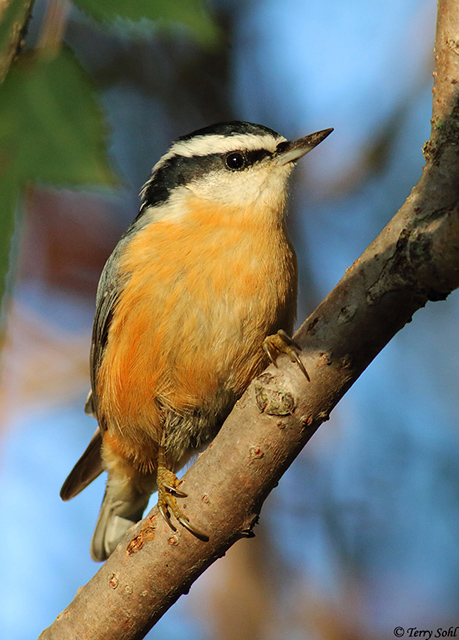 Red-breasted
Nuthatches are a very tame winter visitor to home feeders in South Dakota,
although they can also be found year-round in the Black Hills. They will
often ignore a human presence just a few feet away as they visit a feeder.
Winter numbers vary greatly from year to year. They can migrate very early
in the fall, often already arriving by September (as with the bird in the photo
to the right).
Red-breasted
Nuthatches are a very tame winter visitor to home feeders in South Dakota,
although they can also be found year-round in the Black Hills. They will
often ignore a human presence just a few feet away as they visit a feeder.
Winter numbers vary greatly from year to year. They can migrate very early
in the fall, often already arriving by September (as with the bird in the photo
to the right).
Habitat:
Nearly always found in conifer-dominated forests during the nesting season. They will utilize all forest habitats during migration and in winter, and are also often found in urban settings.
Diet:
Red-breasted Nuthatch primarily eat insects and other small invertebrates in the summer months. During the winter months, most of their diet typically consists of the seeds of conifer trees..
Behavior:
Feeds by clambering along the trunks and branches of trees. They will use crevices in tree bark as a seed cache, storing seeds for later retrieval.
Nesting:
May through July. Red-breasted Nuthatch are cavity nesters, and they are one of the few non-woodpecker species to excavate their own cavity. Females do most of the nest site excavation, helped some by the male, who also may bring food to the female while she excavates. They typically build cavities in aspen or other trees with a wood that's easier to remove, and usually in a dead tree or dead part of a tree. Once excavation is complete, a base in constructed in the bottom of the cavity, consisting of grasses, bits of bark, moss, feathers, or other material. The entrance to the nest and the inside opening are typically coated with pine resin. The purpose is unknown, but it's thought to potentially deter predators and/or reduce insect pests. The female lays between 3 and 7 eggs, and she alone incubates them. The young hatch after 12-14 days, and fledge from the nest 16-20 days after hatching.
Song / Calls:
The most often heard vocalization of a Red-breasted Nuthatches is a nasal, tin-horn sounding yank-yank-yank call, which can vary in speed and length. Single yank notes may be given, or longer series may be given.
- Click here to hear the yank-yank-yank calling of a Red-breasted Nuthatch1
- Click here to hear slower-paced yank calls of a Red-breasted Nuthatch2
- Click here to hear very fast-paced alarm calls of a Red-breasted Nuthatch3
- Click here to hear rapid trilling calls of a Red-breasted Nuthatch at its nest site4
Migration:
Red-breasted Nuthatches are permanent residents in much of Canada and the mountains of the western United States. Numbers and distribution in the rest of the United States vary greatly in winter from year to year.
Interactive eBird Map:
Click here to access an interactive eBird map of Red-breasted Nuthatch sightings
Similar Species to Red-breasted Nuthatch:
There are two other nuthatch species in South Dakota, and another in the southeastern US that could potentially be confused with the Red-breasted Nuthatch.
- White-breasted Nuthatch - White-breasted Nuthatch are common in much of South Dakota, and could easily be found in conjunction with Red-breasted Nuthatch. The names alone give away a primary means of telling them apart, as the White-breasted Nuthatch has mostly white underparts, with some chestnut-coloring under the tail. The Red-breasted Nuthatch has a rusty reddish color on its underparts. Both species have bluish-gray upperparts, a white face, and a dark cap, but the face of a White-breasted Nuthatch is plain, while a Red-breasted Nuthatch has a bold black stripe through the eye. White-breasted Nuthatch are noticeably larger than Red-breasted Nuthatch, but size can be difficult to judge in the field.
- Pygmy Nuthatch - In South Dakota, Pygmy Nuthatch are a rare resident of the Black Hills, and not likely to be seen far outside of that area in the state. As the name implies they are slightly smaller than a Red-breasted Nuthatch, but size alone is difficult to judge in the field. Pygmy Nuthatch may have a whitish to a light buffy-colored belly and chest, and in certain light, those with more color underneath could resemble a Red-breasted Nuthach. Note the strongly different head patterns though, with a simple dark cap on a Pygmy Nuthatch, the white face with black eyeline on a Red-breasted Nuthatch.
- Brown-headed Nuthatch - Brown-headed Nuthatch are found in the southeastern US and aren't going to cause an identification issue with Red-breasted Nuthatch in South Dakota. In range where their paths might cross, Brown-headed Nuthatch have a similar bluish back, but have light whitish underparts, and a head pattern that consists of a white throat and lower face, with a brown cap that extends back to the nape, and downward through the eye. Compare to the strong striped appearance of the face of a Red-breasted Nuthatch.
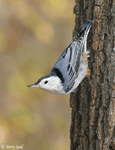 |
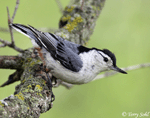 |
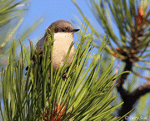 |
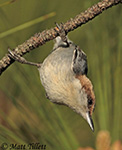 |
| White-breasted Nuthatch | White-breasted Nuthatch | Pygmy Nuthatch | Brown-headed Nuthatch |
Feeders:
Red-breasted Nuthatch will come to feeders for sunflower seeds, various nuts, and suet.
Conservation Status:
Systematic surveys over the last few decades have shown substantial increases in populations of Red-breasted Nuthatch. They are found across a very broad geographic range, and they are common in many parts of that range. The IUCN considers the Red-breasted Nuthatch to be a species of "Least Concern".
Further Information:
Photo Information:
September 23rd, 2018 - Newton Hills State Park - Terry Sohl
Additional Photos:
Click on the image chips or text links below for additional, higher-resolution Red-breasted Nuthatch photos.
AAudio File Credits:
- 1Christopher McPherson. Recorded in Hillsborough County, New Hampshire on February 5th, 2020. Original recording and information available from xeno-canto.
- 2Martin St-Michel. Recorded in Quebec on May 21st, 2017. Original recording and information available from xeno-canto.
- 3Bates Estabrooks. Recorded in Anderson County, Tennessee on November 5th, 2016. Original recording and information available from xeno-canto.
- 4Martin St-Michel. Recorded in Quebec on May 19th, 2016. Original recording and information available from xeno-canto.
| Click on the map below for a higher-resolution view |
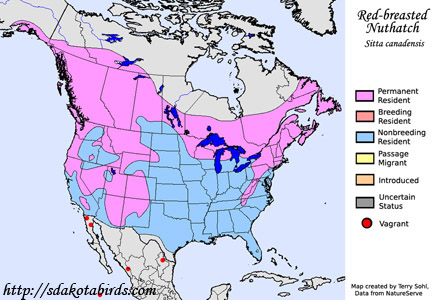 |
| South Dakota Status: Common permanent resident in the Black Hills. Uncommon and local permanent resident in other pine forests of the extreme western part of the state. Uncommon to common winter visitor in the rest of the state. |
Additional Red-breasted Nuthatch Photos
Click for a higher-resolution version of these photos
